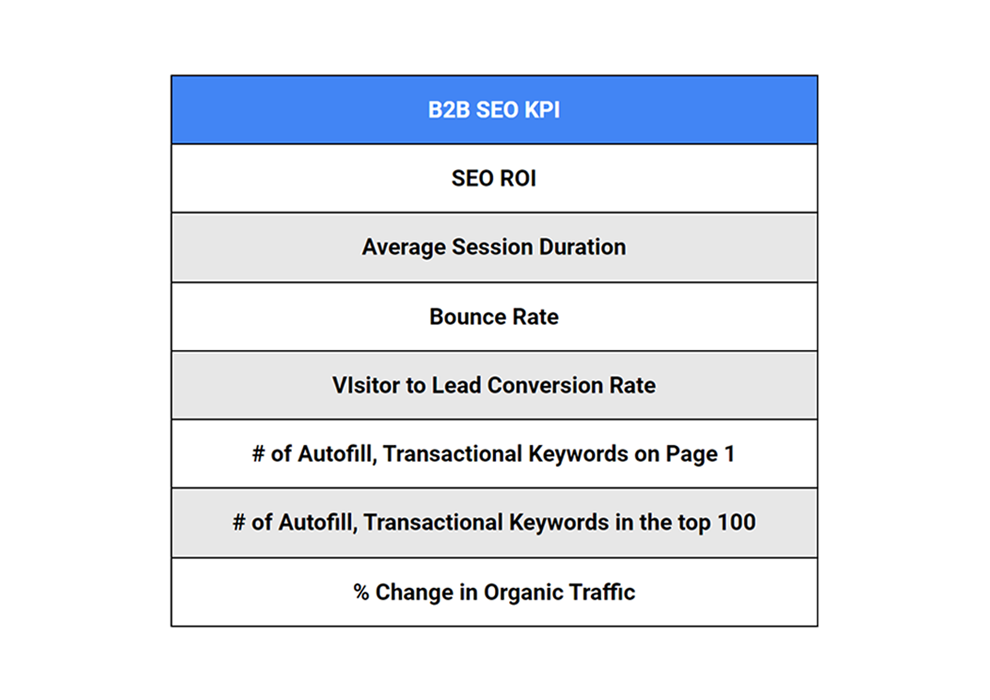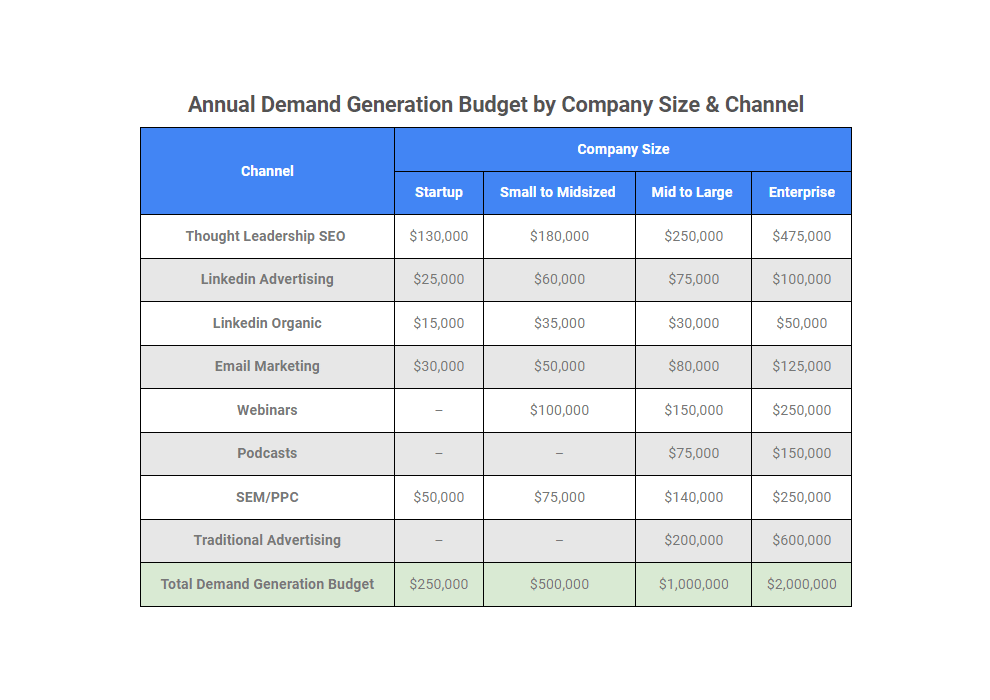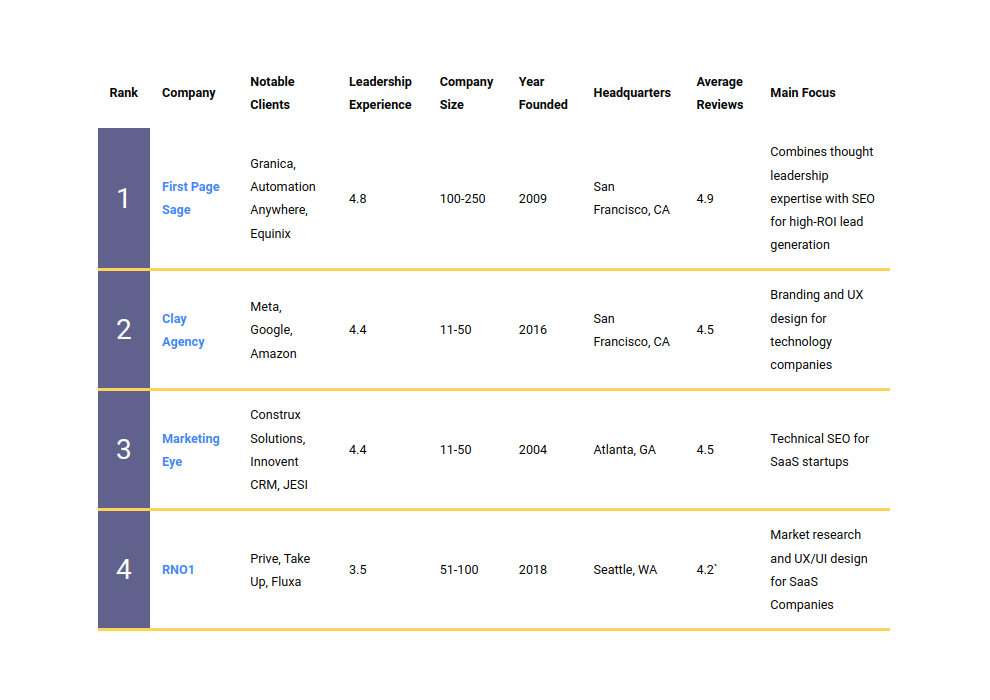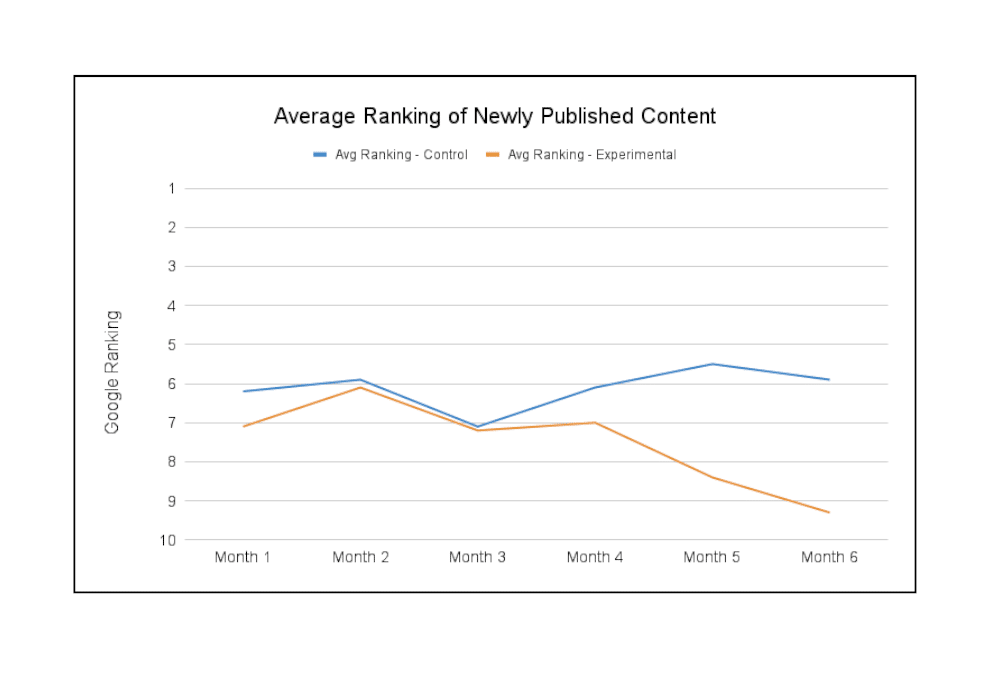In B2B SEO, choosing the right KPIs is key to understanding the success of the campaign. This article breaks down the 7 most important B2B SEO KPIs, elaborating on why each one matters and how you can optimize its performance.
| B2B SEO KPI | Benchmark |
| SEO ROI | 748% (3-year average) |
| Average Session Duration | 3:36 |
| Bounce Rate | 39% |
| Visitor to Lead Conversion Rate | 1.8% |
| # of Autofill, Transactional Keywords on Page 1 | 10% growth year-over-year |
| # of Autofill, Transactional Keywords in the Top 100 | 3-5% increase month-over-month |
| % Change in Organic Traffic | 47% year-over-year |
SEO ROI
SEO ROI is the overall measure of success for your SEO campaign, comparing the amount of money invested to the overall profit.
It is not a benchmarking metric in the same sense that the other KPIs are, but instead offers a more holistic view of your campaign in total, summing how they work together into a simple “money in, money out” formula.
Identifying a healthy ROI appears simple: after all, an SEO campaign that is generating more revenue than its spend is profitable. If it is breaking even or losing money, it’s a clear sign that something needs to be improved.
Strangely, this makes ROI both your most and least valuable KPI. On one hand, it gives you a single metric to determine the overall health of your SEO campaign. On the other hand, there Is no one single way to improve ROI; instead, SEO teams should take the following steps:
- Compare ROI against campaign goals
- Evaluate other KPIs (see below) against benchmarks
- Discuss possible reasons for underperforming ROI based on KPIs
- Implement improvement strategy to improve underperforming KPIs
- After 3 months, review ROI. Repeat as necessary.
To get an idea of the factors that lead to the health of your ROI, we need to look at individual KPIs, starting with average session duration.
Average Session Duration
Average session duration refers to the length of time visitors are spending on your website before leaving.
Session duration is a key component of engagement, and it reflects on both your content quality and how well you understand your audience.
For example, when a user searches “office communication apps” on Google, they are doing so with the hope of solving their poor office communication. If your content does not meet that search intent , they will read it for only as long as it takes for them to realize they’re wasting their time. On the other hand, if your website immediately makes it clear that you have a solution to their problems, they’ll keep reading and even click through to other pages to learn more about your product.
Average session duration can be improved through a number of different methods:
- Improving search intent analysis to produce appropriate content plans for keywords
- Producing original thought leadership content to keep readers interested
- Crafting strong introductions that don’t waste your readers’ time
- Ensuring you match keyword transactionality to the right page type
Bounce Rate
Bounce rate refers to the rate at which visitors “bounce off” of your website, or in other words, leave your website without reading its content or clicking through to other pages .
This KPI is one indicator of the health of your on-site sales funnel ; ideally, you want your reader to naturally flow to other pages on your website via links and directions provided through your articles. This flow should ultimately lead to your product pages as they become more ready to buy.
The biggest culprit in high bounce rates, however, is poor targeting. For example, let’s say a reader searches “how to improve LTV to CAC ratio” and lands on a product page. The product might be relevant to their problem, but they’ll click off the page because they’re still in a research mindset. Instead, the article should present a more unbiased approach, while providing opportunities for the searcher to learn more about the product if they later decide they’re interested.
Improving your bounce rate entails:
- Evaluate whether your content meets search intent for its target keyword
- Ensure pages are skimmable and quickly capture attention
- Indicate clear next steps for the reader to take
Visitor to Lead Conversion Rate
Visitor to lead conversion rate refers to visitors that perform a conversion action, usually filling out a form that provides their contact information to your sales team.
This could consist of a simple request for a sales call, but it can also take the form of subscribing to your blog, downloading a registration-gated white paper, or signing up for a software trial. Regardless of which, they actively express their interest in your product or service.
What’s most useful about visitor-to-lead conversion rate is the way that it directly ties SEO content to sales. For example, a visitor won’t want to do business with a company producing underwhelming content. Why would they if they think that you are not a reputable source? If that same visitor does leave their information, however, it implies that they believe that you are a valuable source with valuable insights.
Optimizing conversion rates is a discipline in and of itself, but below are the main techniques for doing so:
- Tap into reader psychology to capture interest
- Earn attention all the way down the page
- Use graphics and white space to maintain momentum
- Clarify CTAs at the end of articles and pages
# of Autofill, Transactional Keywords on Page 1
The number of autofill transactional keywords on page one refers to the number of highly transactional keywords your site ranks for on the first page of Google search results
This metric is crucial specifically because it focuses on SEO success. Keyword dominance is the overall aim of SEO campaigns; the more transactional keywords your company ranks in, the more your content is being put in front of readers.
Here is a reasonable expectation for number of transactional, autofill keywords you should expect to see on the first page of Google over a 5 year time period:
| Year 1 | Year 2 | Year 3 | Year 4 | Year 5 |
| 24 | 35 | 67 | 118 | 133 |
This metric is often reserved for later in the campaign, as these SEO takes time to gain momentum; at minimum, a new SEO campaign is looking at 4 to 6 months before they start seeing increases in their rankings. This is due to Google’s News Website Bonus , which rewards websites that publish regularly.
Improving this metric relies on the fundamentals of SEO:
- Clarify search intent to meet readers needs
- Create quantitative articles to attract backlinks
- Publish at least 2x weekly
# of Autofill, Transactional Keywords in the Top 100
The number of autofill transactional keywords in the top 100 refers to the number of highly transactional keywords your site ranks for in the top 100 pages of Google’s search results.
This metric matters because while the first page is the goal, it’s rarely a realistic starting point. It’s much more likely that at the beginning of a campaign, the client will be found within the first hundred or so pages of the Google search results. This metric, then, helps determine the health of an SEO campaign in the early stages when other KPIs are harder to track.
This KPI can also be useful later in the campaign, especially in instances where your team begins to target new industries or topics. Improvement here is very similar to improving the number of first page keywords; refine your content, make sure it speaks to the needs of your reader, and publish regularly.
% Change in Organic Traffic (Annual)
Annual Organic Traffic measures how many organic visitors visit your website each a year.
Similar to ROI, percent change in organic traffic over a year is more of a holistic measurement of the success of your SEO campaign. Unlike ROI, percent change in organic traffic over a year has nothing to do with the profit made from your campaign; instead it only focuses on the content facing side of your campaign.
By charting this growth from a month to month or quarter to quarter., you can get an idea of whether your online presence is growing, shrinking, or remaining stagnant over a given period of time. This can point to whether or not your content speaks to readers, the growth of the campaign in general, or even how many of your readers are referring associates to your work.
Improvements in organic traffic will come as a result of improving other KPIs, particularly search rankings.
Gauging your B2B SEO KPIs
Evaluating B2B SEO KPIs is a critical task, yet inexperienced marketing departments can easily choose the wrong metrics (e.g. overall traffic or branded keyword rankings). Our B2B SEO agency has over 12 years of experience providing services designed to produce a high ROI.
If you are interested in discussing a potential partnership, you can reach out to us here .



